
T-Mobile continues reaching for the stars
T-Mobile’s partnership with Starlink for satellite, direct-to-device cellular service is gaining publicity with advertising, as a way to keep customers connected in areas lacking cell service. This is frequently marketed for connectivity in remote areas, featuring hikers who want to share locations and the views, with use cases for emergencies as well. Now, it has been determined that the satellite power is expected to reduce traditional terrestrial network output in turn, resulting in opposition from AT&T, Verizon and EchoStar. Aware of this prediction, the FCC will determine whether to allow Starlink/T-Mobile’s initiatives to follow through based on the impacts seen during a temporary order. Satellite service is not intended to replace regular cellular networks, as the service’s capacity is not as robust. The current beta version of T-Mobile’s direct-to-device satellite product is available to customers of any cellular service provider.
The Circana Take:
- It makes sense that consumers, especially frequent travelers or those living in areas of low cellular coverage, are enticed by a service that enables connectivity from anywhere. Messaging must remain clear, however, that satellite is not a replacement for cellular service, and that traditional cellular service will continue to be standard.
- According to Circana’s August 2024 Mobile Connectivity Study, 5% of consumers are dissatisfied with their cellular provider because they often find themselves outside of coverage areas, and 9% cite dissatisfaction due to poor network reliability. If new satellite technology further decreases reliability and coverage of current user service, the impact to the average consumer must be addressed. The upcoming March 2025 Mobile Connectivity Study will explore consumer awareness and interest in smartphone satellite connectivity.
Comcast broadband speeds soar with new mobile promo
Comcast, provider of home broadband Wi-Fi and Xfinity Mobile services, is cross-promoting a new combination discount. Comcast is offering a free unlimited line of Xfinity Mobile service for one year with subscriptions to their 400Mbps or faster Comcast broadband, for new and existing home broadband customers. The price of one unlimited mobile line is typically $40 per month. This could be the start of new bundling initiatives by the company and attempts to grow its mobile base using both current and prospective broadband customers. At the same time, they are enhancing the speed of their broadband offerings.
The Circana Take:
- Bundling services at discounts to the consumer is a way to attract customers or increase spend. The fact that this offer is available to new and existing customers creates an advantage due to consumers’ general hesitancy toward switching to a cable providers’ cellular service. Comcast customers who already trust the broadband provider may be more likely than other segments to switch to the cable MVNO’s cellular service. Circana’s August 2024 Mobile Connectivity Study found that 26% of cell phone owners would be extremely or very interested in switching their cellular service to their cable or Internet provider at a comparable or less expensive rate.
- While this is a start, there is room to grow in the realm of converging services. In this vein, the March 2025 Mobile Connectivity Study will investigate pros and cons of convergence of multiple services into one monthly bill for customers.